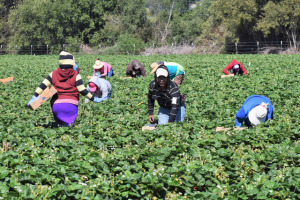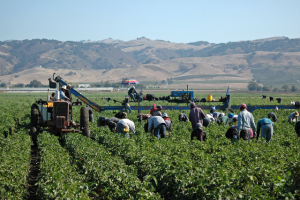Health, Food and Reform
May 20, 2011 Michael R. DimockPresentation to the Southern California Public Health Officer Meeting
The Children’s Bureau, Los Angeles, CA
Public health officials from 8 counties and 2 cities in Southern California met to discuss forming a collaborative effort to prevent disease and injury for those they serve. ROC president, Michael R. Dimock, was asked to speak about the power of regional collaboration and to recommend policy goals that these officials might collectively pursue to ensure a healthy food and agriculture. Larry Cohen and the Staff of the Prevention Institute, which has been playing a catalytic role along with Ag Innovations Network in bringing public health officials into food system change activities, facilitated the meeting. The health departments of Los Angeles and San Diego hosted the meeting.
Thank you for holding such a visionary meeting. I speak for the 55,000 members of the Roots of Change Network in saying it feels like the cavalry has arrived. Those working to prevent disease and protect individual and community health are the essential ingredient, the powerful allies, long seen and sought by people working for transformation of food and agriculture. So I am thrilled to be with you here today.
Since I am going to speak about food systems, it is important that I first offer a definition of the food system, which is one adapted from the WK Kellogg Foundation, a long-time investor in food system reform, as found in the recently published Good Food For All Agenda for Los Angeles:
A healthy equitable, and sustainable regional food system is a complex set of activities and relationships related to every aspect of the food cycle, including production, processing, distribution, retail, preparation, consumption, and disposal.
Clearly this is a big hairy system with many complex relationships and a long history of regulatory intervention.
Why is the food system becoming a topic of deep concern for the healthcare and public health community?
This mammoth system, one of the three primary systems underlying civilization (the others being energy and water, which are both highly integrated with food), has evolved into something that is having widespread and deleterious impacts on human health.
There are four basic impact points. The first is climate. Worldwide 18% of the green house gases altering climate come from agriculture and food system activity (10% from agriculture and 8% from off farm food related energy use). 20% of world energy budget is used by the food and agriculture system (this include water pumping). A large share of this energy, almost 20%, is for creation of nitrogen fertilizer, which is the very backbone of the agriculture’s high level of productivity. Nitrogen leakage into the environment is also a serious pollutant. Two-thirds of coastal rivers and bays in the USA are moderately or severely degraded by nutrient pollution primarily nitrogen.
The second impact point are toxics effecting plant, animal and human tissues, which are delivered by the food system through water and air pollution or residue on fruits and vegetables. Fertilizers, animal waste, and eroded soils are degrading water quality and creating air pollution that impact intestinal and lung health. Diesel fuel particulates from on farm engines and food transport systems cause asthma and worse. Pesticides and other chemicals in agriculture and food production or packaging have been linked to endocrine disruption and cancer. Confirmation of concern can be found in the 2010 report of the President’s Cancer Panel under the National Cancer Institute. This panel recommended that one strategy for reducing cancer risk is to eat organic food.
Food born illness is the third impact on public health from the food system. Data suggests that packaged produce, meat and dairy, and tainted seafood from water borne bacteria and viruses are the primary sources. Frequent media reports would indicate that large production plants have become vectors for E. coli, salmonella, listeria and other pathogens that make tens of thousands of people ill each year.
Finally, in the last 30 years the nutritional quality of food has degraded and malnutrition is rampant as evidenced by obesity and diabetes rates. High fat, sugar and salt, too little fiber in highly processed food are the culprits. Poor communities of color and particularly children are disproportionately impacted by poor food quality because of very limited access to fresh affordable food. You all know better than me the damage that is occurring to our future generations. I can report that I have been in meetings with United Health Group, among the nation’s largest healthcare companies, the leadership of which as concluded their financial future is dependent on lowering obesity rates.
So that is the bad news. Obviously the question is what can we do?
Roots of Change believes you need to connect all the stakeholders in the system who have the knowledge, roles, responsibilities and desire to fix the system through creation of a coordinated body of actors that share a strategy, goals and tactics. We further believe you need to work at the local, state and federal level to affect the required changes because each level has unique leverage points within their grasp.
I am thrilled to hear that you are investigating formation of a regional collaboration. We have worked on forming and supporting regional collaboration since our implementation work began in 2007. As has been mentioned, we have worked with health officials, policy makers, NGOs, community stakeholders, farmers and ranchers on large regional approaches in the San Francisco Bay Area, here in Los Angeles and now we are doing the same in San Diego through what we call Urban-Rural Roundtables. These simple processes focus on developing policy recommendations for mayors, supervisors and council members.
I should mention that the model for ROC’s current work actually began in Ventura County in 1999, when a consensus building body called the Ag Futures Alliance was formed. It was populated by farmers, environmentalists, civil society groups and public officials who agreed that agriculture had to be preserved despite the fact that enviros, labor advocates and aggies from the county where actively suing each other and engaged in a kind of warfare. Simultaneously, there were nearly 3000 farmworkers living under bridges and in other substandard housing. And farm worker housing could not be built due to “nimbyism” (not in my back yard). This broad based coalition of former enemies from right to left politically and the public and private sectors arrived at consensus on how to get housing built. They got ordinances changed in the cities and county, raised money, and have subsequently built hundreds of new units as a result.
Based on that model, ROC continued its work up and down the state, at the state and local level. I cannot share all the examples, but I can say that the 2009 San Francisco Urban-Rural Roundtable, composed of another broad cross section of stakeholders from the city itself and 150 mile radius around it, resulted in an Executive Directive from then Mayor Gavin Newsom that caused a dozen city departments to think through how their work could improve healthy food access and stimulate regional food system development. Procurement and permitting policies have been changed to align with health and ecological sustainability goals. It also led to stimulation of urban agriculture. It will result in a doubling of acreage, which can become an important component in improving food choices for low-income people.
Regional collaboration is powerful because it gives policymakers an easy way to say yes. If the community is divided, they can easily say no. An alliance of atypical actors is a sure way to create new policy. So we would heartily endorse a collaborative effort by public health officials from southern California because we think it could be very effective if focused on some important change levers at the local, state and federal level.
In closing, let me make some recommendations on policies or activities you might want to consider as targets for a common message or common goals.
At the federal level, there are two policy changes to the federal Farm Bill that you might seek to support through whatever mechanisms you have at your disposal.
The first is development of a very robust nutrition incentives program that will provide matching funds to nutrition assistance clients who use their EBT cards or WIC vouchers to purchase fresh fruits, nuts and vegetables. Some of the nutrition title funds should be used for what are called “fresh funds,” “double-up bucks” or “top up” funds so that a recipient that comes to a farmers market or another retail venue can double their purchasing power for fresh food. We at ROC like the farmers market programs because they have double impact. They increases access and consumption of fresh healthy food for low income populations while at the same time expanding demand for local or regional fresh produce grown using more sustainable growing practices that have less negative impacts on the environment.
There is a related program we are piloting now with aid from our national partner Wholesome Wave. It is called Veggie Rx. In this program doctors write prescriptions for 6 months of veggies for families suffering from health related disease. The prevention portion of the new Health Care bill could cover the cost of these vegetables.
The second change to the Farm Bill is to end commodity payments for the production of cheap corn and other “program crops.” Farm bill payments to farmers should be tied to two goals: healthy food production and environmental protection. In short, the Farm Bill needs to reframed to create healthy food instead of cheap food, which is what is was originally designed to do, did very well, but which has had many unintended negative consequences for human health, ecosystem health and rural economies.
The other big policy change is around the sub therapeutic use of antibiotics in meat production. Harvard and other medical research institutions have stated that the use of these drugs in confined animal feeding operations is very dangerous. It is destroying their efficacy in combating human disease. The next plague could very well emerge from a meat factory.
At the State level, we need to pass and fund a healthy food financing bill like Pennsylvania has. The California Endowment has put up $200 million and we think the State should become a partner. The Healthy Food Finance Initiative (HFFI) provides money to open traditional and nontraditional retail in food swamps or deserts in order to improve healthy food access.
Another Statewide policy is to provide more research money to the UC and CSU system to develop sustainable farming practices that protect water and air, reduce use of toxics, water and energy in food production.
Finally at the regional or local level we need to form public-private partnerships that are seeking enhanced health, more jobs and healthier food through revamping or creating new regional food infrastructure. We know that the root cause of health disparity is wealth disparity. So let’s use job creation in the food system to kill two birds with one stone. Working together we can help people take control over their community food supply by producing food and make money by selling it. New regional enterprises are needed for small scale processing plants for produce and proteins. We also need local-first procurement policies so that our schools, hospitals, and other institutions are buying fresh local food, not highly processed or fast food.
So in closing let me say again that I am thrilled you are thinking systemically and regionally. Roots of Change wants to help you all when the time is ripe!



